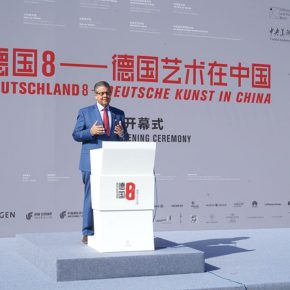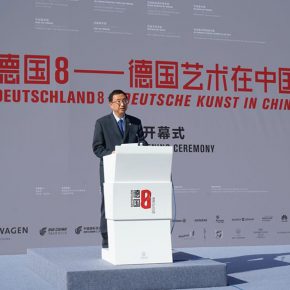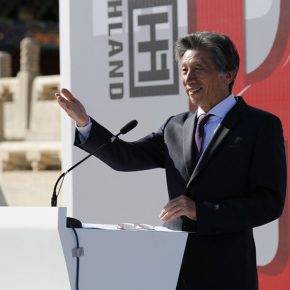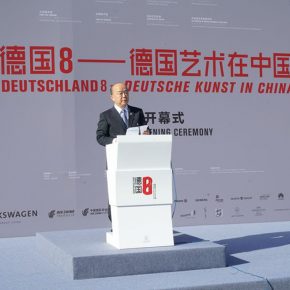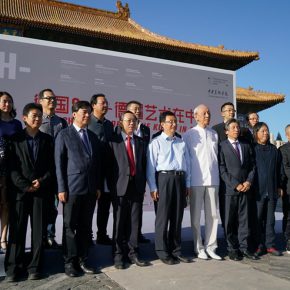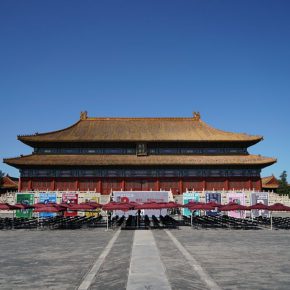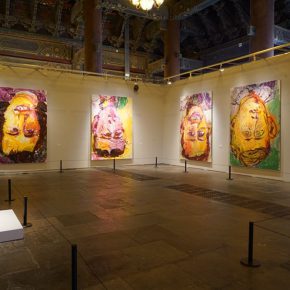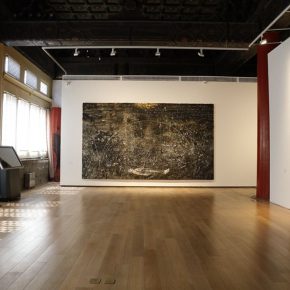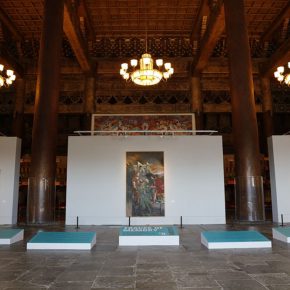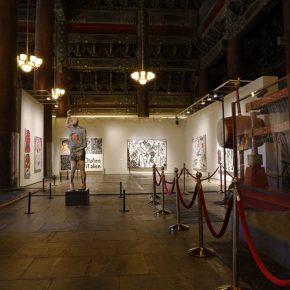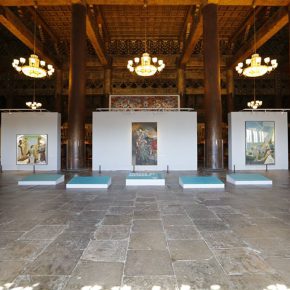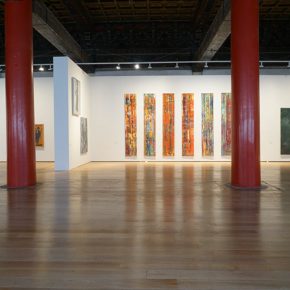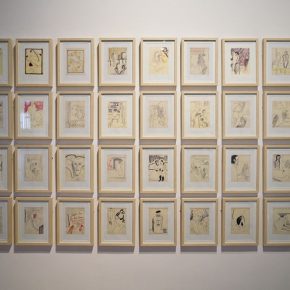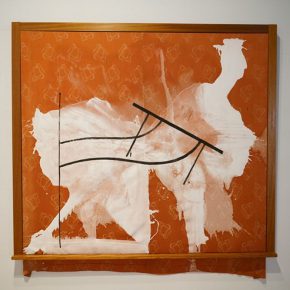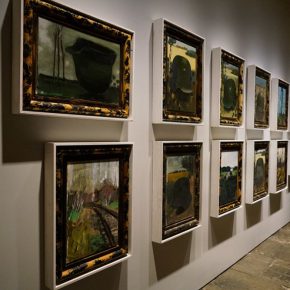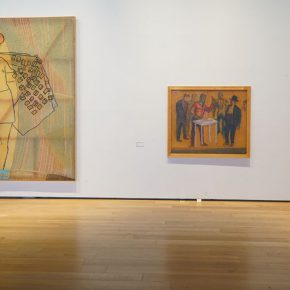
On the afternoon of September 17, 2017, the opening ceremony of the “Deutschland 8: Deutsche Kunst in China” was held in a grand style?in the Imperial Ancestral Temple Art Museum, which meant that the feast of art and culture that had been warming up for a long time opened in full swing. “Deutschland 8” is an important exhibition in the cultural program of the 45th anniversary of the establishment of diplomatic relations between China and Germany, and also the largest German art exhibition held in China in recent years. It has been organized by Stiftung für Kunst und Kultur e.V. (Foundation for Art and Culture Bonn) and the Central Academy of Fine Arts, with Prof. Fan Di’an, President of the Central Academy of Fine Arts, and Prof. Dr. Walter Smerling, Chairman of the Stiftung fu?r Kunst und Kultur e.V as general curators, the art project is a panoramic display of post-war German art, so the audience can closely see German art with different themes in CAFA Art Museum, the Imperial Ancestral Temple Art Museum, Beijing Minsheng Art Museum, Today Art Museum, Red Brick Art Museum, Yuan Art Museum, and Whitebox Art Center, seven academic thematic shows and a thematic forum form an effective interconnection, commonly showing the development context of postwar German art and the German art quality that is presented in the context of cultural globalization.
The opening ceremony of the exhibition was held in the ancient Imperial Ancestral Temple. The honored guests attending the opening ceremony included: Sigma Gabriel, Deputy Prime Minister of the Federal Republic of?Germany and Minister for Foreign Affairs, Luo Shugang, Minister of Culture of the People's Republic of China, Michael Clau?, Ambassador of the Federal Republic of Germany to China, Shi Mingde, Ambassador of the People’s Republic of China to Germany, Xie Jinying, Director-General of the Bureau for External Cultural Relations at the Ministry of Culture of the People's Republic of China, Zheng Hao, Deputy Director-General of the Bureau for External Cultural Relations at the Ministry of Culture of the People's Republic of China, Wan Lijun, Deputy Director of the Division of Sports, Health and Art of the Ministry of Education of the People's Republic of China, Gao Hong, Secretary of the Party Committee of the Central Academy of Fine Arts, Xu Li, Secretary of the Party Committee of the China Artists Association, Wu Weishan, Director of the National Art Museum of China, Xie Xiaoquan, Deputy Director of the National Museum of China, the famous artist Prof. Zhan Jianjun and Prof. Zhong Han from the Central Academy of Fine Arts, Prof. Walter Smerling, Chairman of Stiftung für Kunst und Kultur e.V. (Foundation for Art and Culture Bonn) and General Curator of the “Deutschland 8”, Zhang Zikang, Director of CAFA Art Museum, Yue Jieqiong and Li Peng, Executive Directors of the Imperial Ancestral Temple Art Museum, Zhou Xujun, Director of Beijing Minsheng Art Museum, Yan Shijie, Director of Red Brick Art Museum, Gao Peng, Director of Today Art Museum, Gu Yan, Director of Yuan Art Museum, Sun Yongzeng, Director of Whitebox Art Center, Feng Gang, Deputy General-Manager of China National Aviation Corporation Group and Vice President of Air China Ltd., Prof. Dr. Jochem Heizmann, Member of the Board of Management of Volkswagen Aktiengesellschaft and President and CEO of Volkswagen Group China, Wan Jie, Chairman of Artron Group, and representative of the Central Academy of Fine Arts, as well as exhibitors from Germany, and representatives from all walks of life. Fan Di’an, President of Central Academy of Fine Arts and a general curator for “Deutschland 8” presided over the opening ceremony of the exhibition.
Sigma Gabriel, Deputy Prime Minister of the Federal Republic of?Germany and Minister for Foreign Affairs addressed the opening ceremony and said that, it was held at the Imperial Ancestral Temple near the Forbidden City of China, which reflects the open cultural posture of China, “China 8” which was held in Germany two years ago to comprehensively display Chinese art and was popular with the audiences, especially the young audiences, he believed that Deutschland 8 as a return visit of “China 8”, would also be popular, and promotes Sino-German culture and relationship which stretches to a deeper field.
Luo Shugang, Minister of Culture of the People's Republic of China delivered a speech and recalled the spectacular events of the “China 8” displayed in Germany, and mentioned that the two countries have formed cultural exchanges in all directions in recent years, which constitute a vibrant, mutually beneficial and win-win situation, while “Deutschland 8” was also a successful example, offering the Chinese audience a valuable opportunity to closely understand German culture & art and the development process.
The “Deutschland 8” program presents 7 exhibitions in 7 art museums, which are all independent, while constituting a whole appearance of “German art”. Prof. Dr. Walter Smerling, Chairman of the Stiftung fu?r Kunst und Kultur e.V and a general curator for “Deutschland 8” delivered a speech and introduced the themes of each show in detail, to summarize the things that have happened in Germany over the 70 years after the end of World War II, and the exhibition witnessed German cultural self-confidence brought by the art. He also mentioned that the exhibition started in such an historic space which was a fantastic moment, and the history, reality, and future were all encountered at the same moment, while people witnessed it together through art. German art is important for the development of contemporary Chinese art, Fan Di’an, President of Central Academy of Fine Arts and a general curator for “Deutschland 8” mentioned two meanings of the exhibition: firstly, it offers a panoramic introduction to the development process of German art since World War II to China, many features can be called the German nature of contemporary art, namely the German cultural spirit and cultural characteristics; secondly, through this exhibition it is possible to establish a broader platform for Chinese and German experts and scholars to research, so that the platform can face the future and promote the cultural exchanges between China and Germany.
Imperial Ancestral Temple Art Museum presents “Traces of Memory: Masterworks of Contemporary German Painting” of “Deutschland 8”. It brings together a group of the most influential art masters in the history of German contemporary art, including the classic “inverted paintings” by Georg Baselitz, the paintings of various themes and styles by the German Neo-Expressionism?Gerhard Richter, Anselm Kiefer’s large-scale paintings and works of installation art infiltrated by a reflection of history and culture, the pioneer of conceptual art Joseph Beuys’s paper works, the leader of the new Leipzig School Neo Rauch’s realistic image fable, Markus Lüpertz’s distinctive series of oil paintings and large-scale wood carvings, Gu?nther F?rg’s comprehensive photographic works are finished by using a variety of materials, A.R. Penck’s visual creation which is compatible with several genres of Western modern art, Sigmar Polke’s “image text” that is full of social concern and deep philosophies, Günther Uecker’s painting installation that emphasizes the breakthrough of the borders. These artists respectively belonged to several important art schools in Germany since 1960. Through their explorations and practices, it continued the durable tradition of painting in Europe and set off the discussion of “the return of painting” in the history of art; on the other hand, they were rooted in the local, concerned about the history and the current social reality, integrating the concern of the times into the innovation and exploration of painting and language of art, with an inclusive style to broaden the developmental dimension of contemporary art.
“Deutschland 8” art project is a panoramic display, an observation and thinking, and also the profound communication between Chinese and German art, which also has a dimensional aspect on inspiration of the artistic development in the open and diverse age of the image. The exhibitions are on show at seven major art museums in Beijing, among the “Traces of Memory: Masterworks of Contemporary German Painting” remains on view in the Imperial Ancestral Temple Art Museum till October 20.
Text by Zhang Wenzhi, translated by Chen Peihua and edited by Sue/CAFA ART INFO
Photo by Ren Shaokun, Fan Gongqing, Liu Jia, Jiao Wei/CAFA


